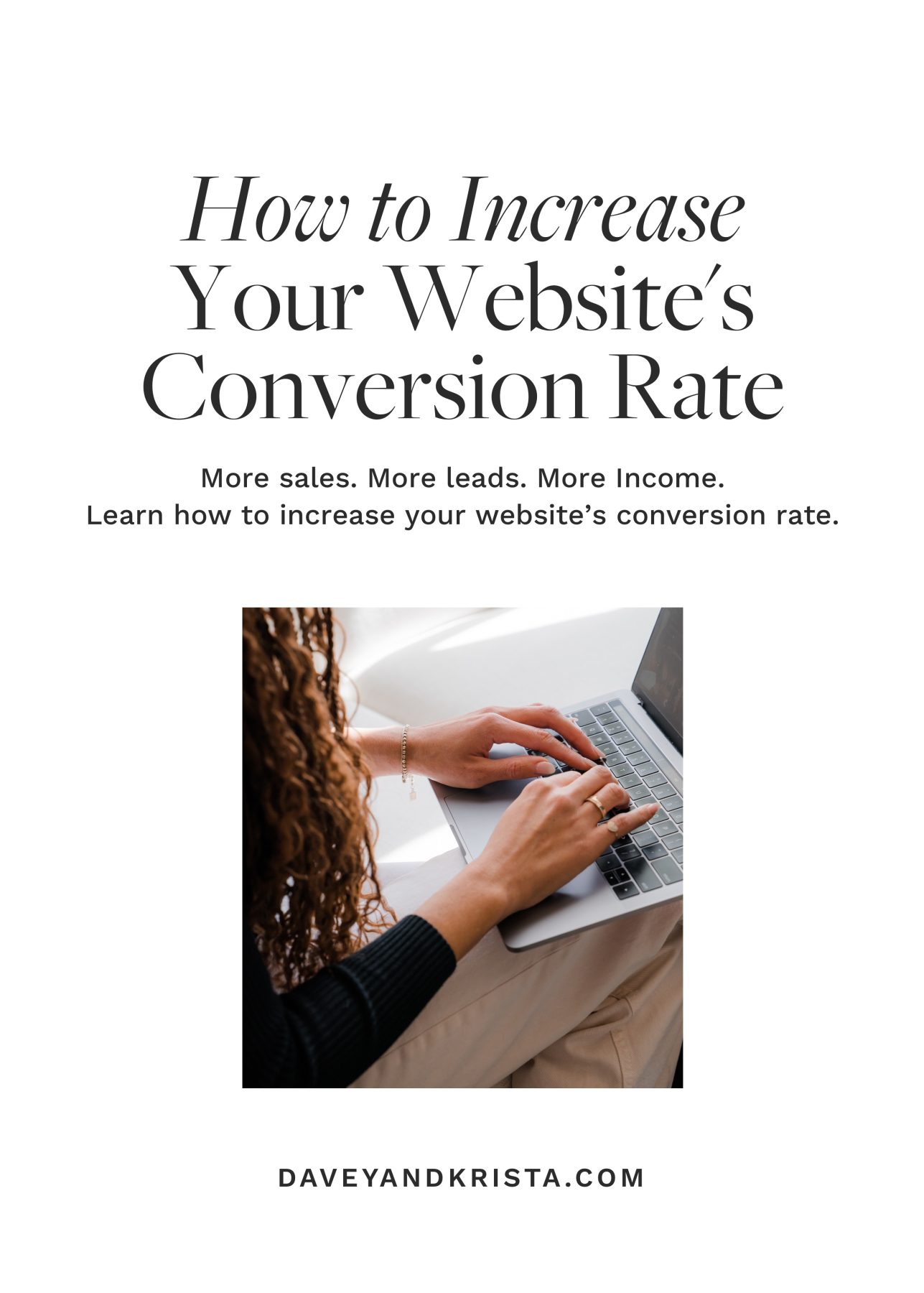Website conversion rate optimization (CRO) is the process of figuring out ways to improve the rate at which people take a desired action on your website. In other words, it’s all about increasing your website’s conversion rate: Getting more people to turn into leads or purchase a product.

Table of Contents
Let’s dive into ways you can increase your website’s conversion rate…
What is website conversion rate optimization?
Your website’s conversion rate is the rate at which visitors on your website take a desired action. In other words, a conversion occurs when a visitor on your website does what you want them to do, whether that’s clicking a specific button, submitting a contact form, or purchasing a product.
Conversions most often refer to leads and purchases. Someone becomes a lead when they figuratively raise their hands to express interest in something by providing you with an email address or phone number for follow-up (or call your business, etc.). For instance, someone completing a contact form on your website would be considered a lead. Or, someone who signs-up to receive a free guide would also be a lead. Purchases are a more obvious conversion that probably doesn’t require any explanation—someone takes out their credit card and pays for a product (or service) on your website.
It’s often more accurate to discuss a given page’s conversion rate. Many websites will be optimizing for more than one conversion. For instance, we offer done-for-you brand and website design services, but we also sell website template designs businesses can download, customize, and launch of their own. Our services’ pages are oriented towards converting leads: Getting people to complete a contact form expressing interest in done-for-you design. Our shop pages are oriented towards purchases: Getting people to purchase a design.
So, what conversion rate are you trying to optimize?
Setting a Goal: What does it mean to increase your website’s conversion rate?
If you’re going to increase your website’s conversion rate, you need to first know what you’re increasing.
Which website conversion are you trying to optimize? Leads? Purchases? All of the above? It’s important to know.
For many of us, we’re at least trying to optimize for leads. We want more people to raise their hand and say, “I’m interested!” by either giving us their email address or phone number so that we can follow up. This will be the primary website conversion for most service-based businesses.
Even if you’re an e-commerce business, you should also have some sort of lead generation strategy in place. However, those of us who run e-commerce websites are probably also interested in increasing the percentage of visitors who purchase from us.
You should set goals based on your current conversion rates. Knowing industry standards can be helpful, but they vary wildly from industry-to-industry and product-to-product. For instance, a high-ticket coach is going to be much more willing to pay potentially $100 for a lead; whereas, that same cost per lead would put a business selling inexpensive widgets on Amazon out of business. This is why it’s important to track your website’s metrics.
How to Optimize Your Website’s Conversion Rate
Here are some practical ways to increase the conversion rate of your website…
Optimize Critical Pages
What are the most important pages on your website? Only you can answer that question, but typically they include your:
- homepage
- services’ pages
- contact page
- product or sales’ pages
- checkout page(s)
- lead generation landing pages
Identifying the most important pages on your website makes your CRO efforts much more manageable. Sure, it could be important to optimize your About Page if you feel like people are dropping-off there… but it’s much more likely that optimizing a lead magnet landing page provides considerably more benefit.
Optimize Hero Spots
When we’re optimizing a page, we almost always start by looking at the hero spot. The hero spot is the area a visitor immediately sees—often called the area “above-the-fold.” We commonly see two mistakes in this area: Either the “promise” or hook of the page is too vague or there’s too much information to process.
We typically check for…
- a hook that teases a very specific benefit
- captivating visual
- strong call-to-action

Improve Your Website’s Copy
A/B Test
There are all sorts of A/B tests you can run. You can test different headlines, benefit-sets, calls-to-actions, images, etc. etc. Typically we start by A/B testing headlines or hooks and then working our way down the page from there.
A/B testing takes time so it is typically something we start doing after we have the initial version live. For instance, we recently launched the Website Conversion Assessment, which is a quiz designed to give people actionable feedback on increasing the conversion rates of their website. The initial version is converting at about 30%, which is the low-end of what we’d consider “normal.” Ideally, it’d be closer to 50%, but it is a longer quiz. Anyways, all that to say that we’re A/B testing the landing page to see if we can increase the conversion rate of the page.
Some tips for A/B testing:
- Get specific about what you’re testing so that it’s easier to understand the results.
- Button-color tests and the like are fun experiments to run, but typically aren’t the kind of A/B test that really “moves the needle.”
- Try to keep variables such as traffic sources
Define Your Funnel or Customer Journey
If you don’t understand your customer’s journey or your funnel, it’s going to be difficult to increase conversion rates. Even service-based businesses should have an idea of what their funnel looks like. Where do people go when they’re looking for a business like yours? How do people find you? When they find you, what questions do they ask?
Even if you just have an idea of how many people you convert to customers after they inquire or find your website, you can increase that number by getting more people to your website. Many people mistakenly think that their website is the traffic generator. It can be with a bit of search engine optimization, but often a sizable portion of website traffic will come from other mediums like social media and email.
Boost Trust Signals
Trust signals include social proof like testimonials, reviews, endorsements, and “featured-in” badges. Social proof is a powerful purchasing factor in one’s purchasing decision.
When’s the last time you bought something on Amazon without reading the reviews? Personally, I filter by Prime Shipping and +4 Star Reviews.
If your website is lacking reviews or testimonials, then you should highly consider incorporating it into your website. We typically recommend including it throughout your website to back-up the various claims you make (versus including it on a Testimonials page that no one reads).

Eliminate Friction
Where might you lose people on your website? I can think of a few culprits:
- Requiring too many form fields on your contact form
- Videos that auto-play with sound (less likely now due to browser updates)
- Only accepting one form of payment
Friction can also be caused by pages loading slowly or tasks not easily being able to be completed. Disorderly top-level navigations are also infamous culprits that make websites more confusing than they need to be.
Here’s the general idea: Examine reasons why someone might not be taking the desired action, then try to fix it.
Focus on Lead Generation
We’ve seen studies saying that as many as 92% of website visitors will visit a brand’s website for a reason other than purchasing the first time they visit. Yes, one way to increase conversion rates would be to figure out how to get more first time visitors comfortable enough to purchase. However, getting people to purchase on their first visit is a tall order for a number of reasons.
This is why lead generation is so important. It gives you a way to follow-up with people and nurture them to purchase from you.
We’ve written extensively about email lists and lead generation, so we won’t rehash all the benefits here. Suffice it to say that many businesses find that their email lists are their highest converting and most valuable marketing and sales channel.

Make It Easy to Start Conversations
Conversations build trust. That’s one reason why email lists are so important. Another way to make it easy to start conversations is to incorporate live chat onto your website.
Live chat makes it easy to answer simple pre-purchase, pre-inquiry questions people might have before taking action. Live chat is probably a better investment for e-commerce businesses than service-based businesses, but we’ve seen service-based businesses successfully incorporate live on their websites too.
Create Urgency
Urgency is making the case for why someone ought to buy now rather than wait. In other words, it’s successfully communicating that the cost of waiting is higher than the cost of taking action now.
Yes, this can be created artificially with countdown timers and quantity-remaining counters—but it can (and should) also be conveyed through your messaging. What does it cost someone if they don’t take action? Lost income? Lost health? Lost memories?
We’ve found that a good copywriter can really help increase the urgency someone feels without having to resort to things countdown timers. With that said, such tools work, which is why we’ve provided instructions for how to incorporate countdown timers into our website designs.
Eliminate Risk
Make a list of reasons why someone might not purchase. How can you eliminate the risk? A popular way to eliminate risk is to have a strong guarantee, like providing someone a refund if the product does not work out.
Even if you can’t provide a money-back guarantee, there’s other ways you can eliminate risk such as pointing to the number of people who have benefited from your product or service. Demonstrating that you have strong customer support also goes a long way in making someone comfortable enough to purchase.
Optimize for Mobile
It’s 2024. I feel like I have to include this on the list, but really this is something that everyone ought to be doing by now.
With that said, we do find that people do not seem to review the formatting of their websites on their mobile devices nearly thoroughly as they do on their desktops. That’s a shame since mobile traffic makes up at least 50%+ of visitors for most websites.
Improve Your Page Speed
Page speed can be a real conversion killer. We’ll occasionally run important pages of our website through a website speed test and explore whether we can increase the page load time. This is something we have to do a few times a year. As you update your website, you’ll find that your website may slow down.
Page speed can be a red-herring for many businesses investigating conversion rates. I’m not saying it’s not important. But for many websites struggling with conversion that we review, we find much bigger issues like mediocre messaging or poor design. Site speed is easy to point to because it’s largely measured quantitatively.

Focus on ONE strong Call-to-Action
A classic conversion-killer is trying to do too much with a given page. Each page should have a mostly-singular focus. Yes, there are exceptions—but you should do your best to guide visitors to take the actions you want them to take. It’s hard to do that when you provide a million different options on a given page.
Focus on improving the CTAs on your website and, typically, conversion rates will also improve.
Is your website not converting? Figure out why…
Since you’re here, we’re guessing that you’re working on ways you can improve the conversion rate of your website. You’ll want to check out our Website Conversion Assessment: It’s a free quiz that examines your website and provides detailed, actionable steps you can take to improve your website.









VIEW THE COMMENTS
Add A Comment